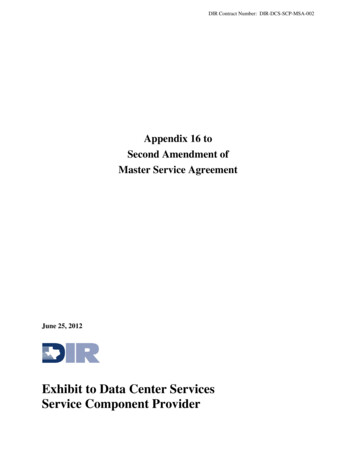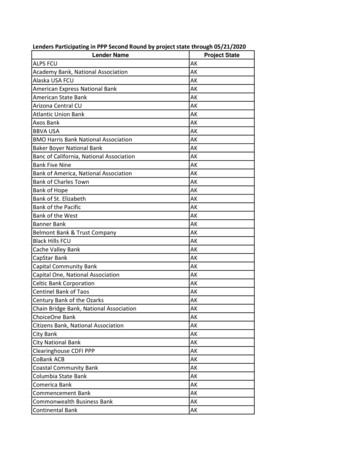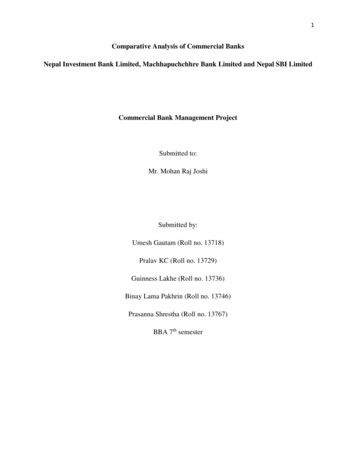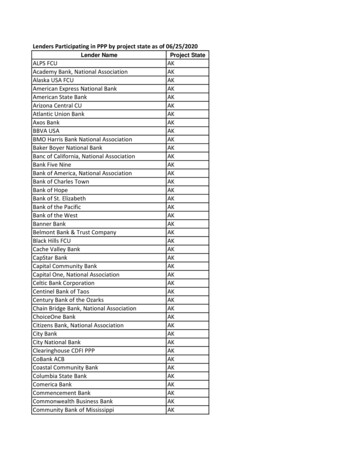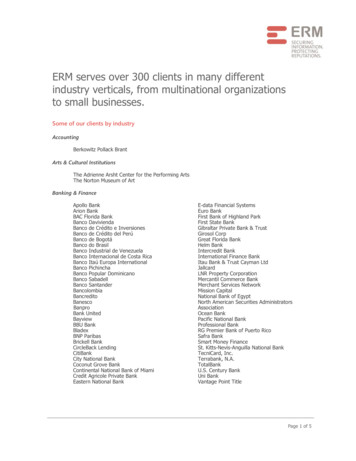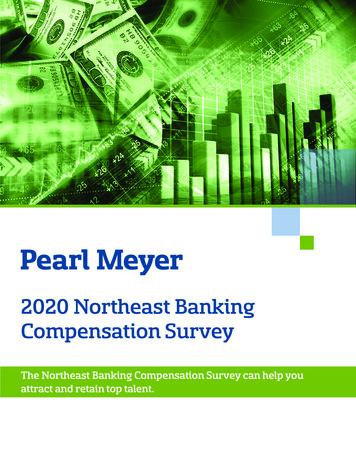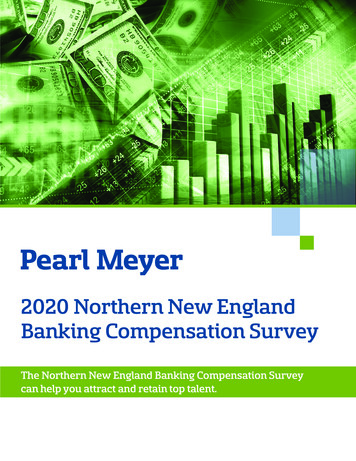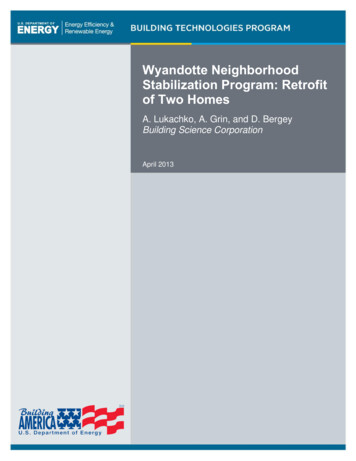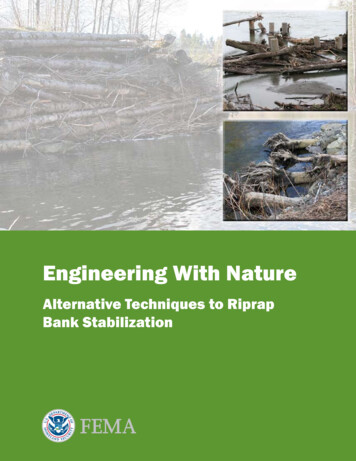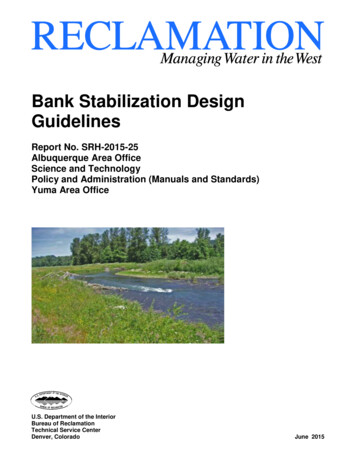
Transcription
Bank Stabilization DesignGuidelinesReport No. SRH-2015-25Albuquerque Area OfficeScience and TechnologyPolicy and Administration (Manuals and Standards)Yuma Area Office1.1.11.1.2U.S. Department of the InteriorBureau of ReclamationTechnical Service CenterDenver, ColoradoJune 2015
Mission StatementsThe U.S. Department of the Interior protects America’s naturalresources and heritage, honors our cultures and tribal communities,and supplies the energy to power our future.The mission of the Bureau of Reclamation is to manage, develop,and protect water and related resources in an environmentally andeconomically sound manner in the interest of the American public.Cover Photograph: Stream vanes on the Calapooia River, Washington. Courtesy of Scott Wright,Natural Resources Conservation Service.
BUREAU OF RECLAMATIONTechnical Service Center, Denver, ColoradoSedimentation and River Hydraulics Group, 86-68240Report No.: SRH-2015-25Bank Stabilization Design GuidelinesReport Prepared by:Drew C. Baird Ph.D, P.E., D.WRE, Hydraulic EngineerSedimentation and River Hydraulics Group,Technical Service CenterLisa Fotherby Ph.D., P.E. Hydraulic EngineerSedimentation and River Hydraulics Group,Technical Service CenterCassie C. Klumpp, M.S., P.E. Retired Hydraulic EngineerSedimentation and River Hydraulics Group,Technical Service CenterS. Michael Sculock, Ph.D., Research ScientistDepartment of Civil and Environmental EngineeringEngineering Research CenterColorado State University.Report Peer-Reviewed by:Blair Greimann Ph.D., P.E., Technical SpecialistSedimentation and River Hydraulics Group,Technical Service Center (Reviewed chapters 1-11 and 13-14)Nathan Holste, M.S., P.E., Hydraulic EngineerSedimentation and River Hydraulics Group,Technical Service Center (Reviewed chapter 12)1.1.51.1.6U.S. Department of the InteriorBureau of ReclamationTechnical Service CenterDenver, ColoradoJune 2015
BUREAU OF RECLAMATIONTechnical Service Center, Denver, ColoradoSedimentation and River Hydraulics Group, 86-68240Report No.: SRH-2013-25Bank Stabilization Design GuidelinesReclamation Authors:Drew C. Baird, Ph.D., P.E., D.WRE, Hydraulic EngineerDateSedimentation and River Hydraulics Group,Technical Service CenterLisa Fotherby, Ph.D., P.E. Hydraulic EngineerDateSedimentation and River Hydraulics Group,Technical Service CenterReport Peer-Reviewed Certification:Blair Greimann, Ph.D., P.E., Technical SpecialistDateSedimentation and River Hydraulics Group,Technical Service Center (Reviewed chapters 1-11, 13 and 14)Nathan Holste, M.S., P.E., Hydraulic EngineerSedimentation and River Hydraulics Group,Technical Service Center (Reviewed chapter 12)Date
DisclaimerThis document was prepared under the sponsorship of the Bureau of Reclamationin the interest of information exchange. The United States Government assumesno liability for its contents or use thereof. The contents of this report represent theviews of the authors and are provided as guidelines. This report does notconstitute a standard, specification, or regulation.The United States Government does not endorse products or manufacturers.Product names are included to show type and availability, and do not constituteendorsement for their specific use.AcknowledgementsThis document was prepared using funding from the Albuquerque Area Office,Reclamation’s Science and Technology Program, Technical Service CenterManuals and Standards, and the Yuma Area Office. Meg Jonas of the U.S. ArmyCorps of Engineers, and Jon Fripp of the Natural Resources Conservation Service,provided their input and review of the topics covered and practical aspects ofguideline contents. Robert Padilla of the Albuquerque Area Office revieweddrafts of this guide and provided valuable comments. Peter Martin of theTechnical Service Center formatted the document and organized figures andtables. These contributions are gratefully acknowledged.ii
Bank Stabilization Design GuidelinesContentsPage1Introduction . 11.1 Challenges of Modern River Design. 11.2 Bank Stabilization . 41.3 Project Development . 51.4 Organization of Design Guidelines . 6PART I – PRELIMINARY INVESTIGATIONS AND METHODSELECTION. 92Project Requirements and General Assessment . 112.1 Design Criteria . 112.2 Ecological Goals . 122.3 Risk Assessment . 132.4 Hydrologic Data for Site Analysis . 142.5 Other Site Data . 172.6 Permitting. 183The Role of Geomorphology in River Projects . 213.1 Geomorphic Assessment . 223.2 Procedural Steps. 233.3 Geomorphic Considerations to Promote a Stable Channel . 244Hydraulic Assessment of Energy, River Form, and Shear Forces . 254.1 Energy and Width/Depth Ratio. 254.2 Energy and Complex Channels . 264.3 Energy and River Form . 274.4 Computing Erosive Force and Assessing Material and MethodsSuitability . 344.5 Traditional Riprap Revetments . 364.6 Sediment Analysis and Modeling . 395Scour Assessment . 415.1 Forms of Vertical Scour . 415.2 Descriptions . 415.3 Countermeasures . 475.4 Scour Assessment Method . 475.5 Scour Computation Topics . 515.6 Basis of Scour Guidelines . 586Selecting a Bank Stabilization Method . 616.1 A Comprehensive Selection Process . 616.2 Methods. 63iii
Bank Stabilization Design Guidelines6.36.46.56.6Preserving the Floodplain . 63Hardening Banks . 66Methods Combination. 67Methods Selection. 69PART II – DESIGN AND CONSTRUCTION . 797Preserving the Floodplain . 817.1 Infrastructure Relocations . 817.2 Conservation Easements . 827.3 Design Procedure . 837.4 Discussion and Recommendations . 858Re-establishing Floodplain . 878.1 Island/Bank Clearing and Destabilization . 888.2 Longitudinal Bank Lowering . 968.3 Side Channels. 1028.4 Channel Embayments . 1089Design of Vegetated, Deformable Banklines . 1139.1 Shape and Deformable Banklines . 1149.2 Vegetation Bank Protection . 1179.3 Live Staking/Pole Planting . 1269.4 Fabric Encapsulated Lifts . 1359.5 Degradable/Deformable Stone Toe. 1399.6 Bio-Engineering on a Stone Toe . 14710 Design of Wood and Boulders . 15510.1 Large Woody Debris and Rootwads . 15610.2 Native Material Revetments . 15810.3 Engineered Log Jams (ELJs) . 16310.4 Boulder Clusters. 17311 Channel Relocations/Construction . 18111.1 Design Procedure . 18211.2 Pilot Channels . 19111.3 Discussion and Recommendations . 19212 Transverse or Indirect Methods . 19512.1 Bendway Weirs . 19712.2 Vanes or Barbs . 21012.3 Spur Dikes (Groins, Hard Points, L Dikes, and T Dikes) . 22512.4 J-Hooks . 23813 Hardened Banks . 24313.1 Upstream and Downstream Limits of the Work . 24413.2 Sizing Riprap . 24513.3 Riprap Revetment . 25213.4 Riprap Windrow and Trench Filled Riprap . 26413.5 Longitudinal Peak Stone Toe . 26914 Future Directions . 275iv
ContentsReferences . 27715 APPENDIX A – Scour Computation Methods . 297A.1 Long Term Aggradation or Degradation . 297A.2 Bend Scour Equations . 301A.3 Confluence Scour Equation . 306A.4 Scour Equations for Near-Structure Locations. 306FiguresPageFigure 4–1. Relationship of width/depth ratio to weighted meanpercentage of silt-clay by Schumm (1960). . . 26Figure 4–2. Channel cross section with low flow channel, bankfullchannel, floodplain, and high flow side channel (NRCS 2007a). . 27Figure 5–1. Example of channel degradation, looking upstream . 43Figure 5–2. Flow structure including macro-turbulence generated by flowaround abutments in a narrow main channel, causing contractionscour. . 45Figure 5–3. Looking downstream past scour at old railroad embankmentand former bridge crossing, and towards a more recentlyconstructed railroad embankment and timber bridge. 45Figure 5–4. Horseshoe scour pattern in a laboratory flume at a circularpier. . 46Figure 5–5. Depth of pier scour hole is partially limited by the pilecap/footing that interrupts the downward diving flow of thesecondary flow pattern . 48Figure 5–6. Generalized relationships for scour in cohesive materials . 53Figure 5–7. . Debris caught on pile-piers of the Old Bridge from springflows at the Little Colorado River, April 2013. . 55Figure 5–8. Arkansas River at Rocky Ford bridge crossing . 57Figure 8–1.Figure 8–2.Figure 8–3.Figure 8–4.Figure 8–5.Island and bank clearing schema
25.06.2015 · BUREAU OF RECLAMATION Technical Service Center, Denver, Colorado Sedimentation and River Hydraulics Group, 86-68240 Report No.: SRH-2015-25 Bank Stabilization Design Guidelines

